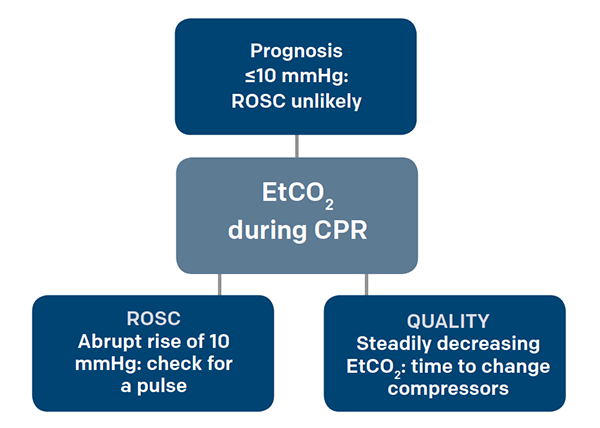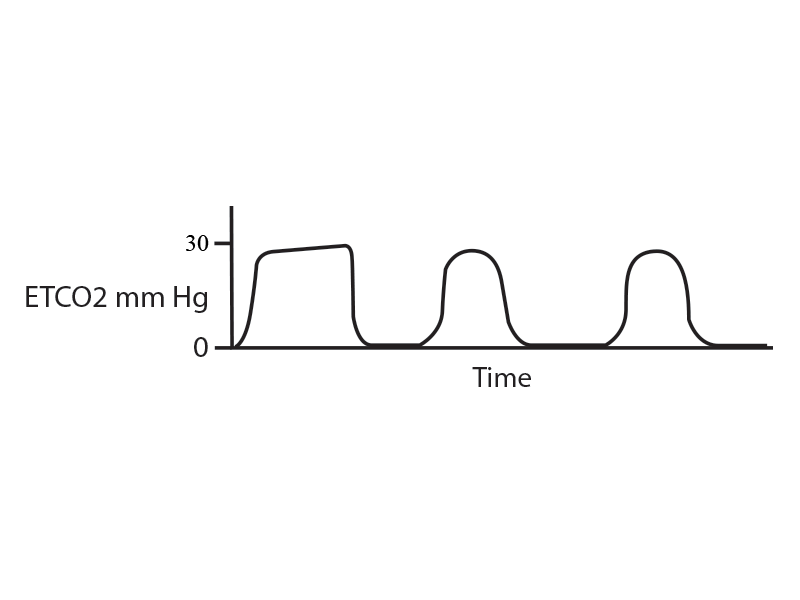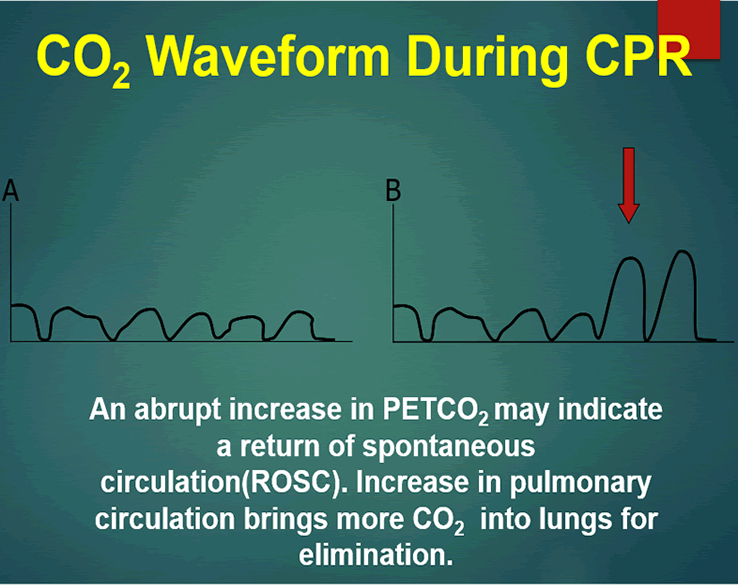low end tidal co2 during cpr
Troubleshoot it with these steps. Evidence suggests a persistently low ETco 2 value and a widened Paco 2-to-ETco 2 gradient during CPR are associated with poor outcomes.

Graphic Recordings Of Aortic Pressure Aop Air Flow And End Tidal Download Scientific Diagram
The first sign of the return of spontaneous circulation ROSC during CPR is increase in ETCO2.

. Abrupt increase in ETCO2 suggests ROSC during CPR detectable before pulse check ETCO2 at 20 minutes of CPR is prognostically useful. A low P a CO2 level is correlated with increased risk of cerebral edema in children with DKA. Graphically this difference in ROSC vs non-ROSC PetCO2 for both groups appeared to be even greater at ten minutes.
These levels of CO 2 were consistent with effective chest compression generating reasonable pulmonary blood flow justifying continuation of resuscitation. End-tidal carbon dioxide. 3 minutes Got low ETCO2 after an intubation during cardiac arrest.
Gradual fall in ETCO2 suggests compressionist fatigue during CPR - time to change compressionists. Understand how capnography or end tidal CO2 helps to monitor integrity of airway cardiac output and CO2 production during anesthesia ACLS sedation emergency medicine prehospital arena intensive care units trauma and assess functionality of breathing circuits and ventilators. End-tidal carbon dioxide ETCO 2 as measured by waveform capnography is considered a physiologic measure of cardiac output in low-flow states and has been proposed in the 2010 consensus resuscitation guidelines as a possible real-time metric to assess the impact of CPR quality.
This pattern not previously described is different from that observed in animal and adult cardiac arrest caused by ventricular fibrillation during which ETCO2 decreases to almost zero after the onset of arrest begins to increase after the onset of effective CPR and increases to. In mmHg the PetCO2 values for those with and without ROSC after five minutes of CPR was. 1 evaluating the effectiveness of chest compressions and 2 identification of ROSC.
4 to 5 CO2 PetCO2 vs. MmHg Relate to the air we breath. Facebook Twitter Linkedin Whatsapp Email.
Expect it to be as high as 60 mmHg when ROSC is achieved. Numerous studies have shown that abrupt increases in ETCO2 pressures exceeding 10 mmHg that remain higher than preceding values suggest an increase in cardiac output and is indicative of ROSC hence the incorporation of such measures in ACLS guidelines1 Patients with values less than 10 mmHg are more likely to die during CPR and. Systematic review and meta-analysis of end-tidal carbon dioxide values associated with return of spontaneous circulation during cardiopulmonary resuscitation.
End-tidal carbon dioxide cannot be used to rule out severe injury in patients meeting the criteria for trauma care. The Impact Of Ventilation Rate On End Tidal Carbon Dioxide Level During Manual. Thus ETco 2 monitoring is a noninvasive way to measure coronary artery blood flow and return of spontaneous circulation during CPR.
End-tidal CO2 ETCO2 detection requires air movement. Low end tidal co2 during cpr. Another use of ETco 2 monitoring is during procedural sedation and analgesia PSA.
Rounded low rectangle EtCO 2 waveform during CPR with a high spike on ROSC. Uses during cardiac arrest. J Intensive Care Med.
The normal values are 5 to 6 CO2 which is equivalent to 35-45 mmHg. 20 mmHg at 20 minutes CPR - higher chance of ROSC. Measurement of a low ETCO 2 value 10 mmHg during CPR in an intubated patient suggests that the quality of chest compressions needs improvement.
During CPR ETCO2 levels were initially high decreased to low levels and increased again at ROSC. Goal is 10 mmHg during CPR. Total pressure of a gas is the sum of the partial pressures of the gas Expired CO2 measured PetCO2 mmHg in waveform Percentage Normal Levels PaO2 85-100mmHg PaCO2 35-45mmHg Percentage vs.
Current guidance recommends an end- tidal carbon dioxide ETCO2 of 4045 kPa 300 338 mm Hg to achieve a low- normal arterial partial pressure of CO2 PaCO2 and reduce secondary brain injury. We compared ETCO2-directed chest compressions with chest compressions optimized to pediatric basic life support guidelines in an infant swine model to. 428 153 mmHg versus 323 141 mmHg.
In mmHg the PetCO2 values for those with and without ROSC after five minutes of CPR was. Chest compression provider tiring end-tidal CO2 value diminishes over time. 5 In low-flow states such as during CPR delivery of CO 2 to.
423 20 mmHg versus 34 255 mmHg. 20 mmHg at 20 minutes CPR - higher chance of ROSC. Two very practical uses of waveform capnography in CPR are.
Prehospital Nitroglycerin for Acute. High quality CPR consistent waveform and end-tidal CO2 20 kPa. High quality CPR consistent waveform and end-tidal CO2 20 kPa.
Loss of ETCO2 may be the first sign that CPR is needed. Throughout the resuscitation end-tidal CO 2 was consistently in the 28-36 mmHg range during VFCPR. Ensure proper rate approximately 100min Ensure proper depth with adequate releaserecoil of thorax 12 thorax or minimum 25 inches Persistently low EtCO.
Goal is 10 mmHg during CPR. Low end tidal co2 range Monday January 24 2022 Edit. Under the Tongue or in a Vein.
By measuring exhaled CO2 many types of pulmonary assessments can be made. 78 Nitrogen 21 Oxygen 1 CO2 and other gases Exhaled gases. Reversible causes of low EtCO2 in CPR.
During CPR ETCO2 levels were initially high decreased to low levels and increased again at ROSC. 428 153 mmHg versus 323 141 mmHg. End-tidal carbon dioxide cannot be used to rule out severe injury in.
Here are five things you should know about waveform capnography in cardiac arrest. End-tidal carbon dioxide ETCO2 correlates with systemic blood flow and resuscitation rate during cardiopulmonary resuscitation CPR and may potentially direct chest compression performance. Normal ETCO2 in the adult patient should be 35-45 mmHg.
By Steve Haywood February 21 2022. 10 to 20 mmHg during CPR was strongly associated with ROSC while persistent EtCO2 below 10 to 20 mmHg after 20 minutes of CPR had a 05 likelihood of ROSC. 11172009 4 Measuring End Tidal CO2 Daltons Law.
By Steve Haywood February 21 2022. This will cause a decrease in the ETCO2 end-tidal CO2 and this will be observable on the waveform as well as with the numerical measurement.

Reversible Causes Of Low Etco2 In Cpr Criticalcarenow

Waveform Capnography In The Intubated Patient Emcrit Project

Reversible Causes Of Low Etco2 In Cpr Criticalcarenow

Etco2 Valuable Vital Sign To Assess Perfusion The Airway Jedi

3 Waveform Capnography Showing Changes In The End Tidal Carbon Dioxide Download Scientific Diagram

Capnography Provides Bigger Physiological Picture To Maximize Patient Care Jems Ems Emergency Medical Services Training Paramedic Emt News

3 Waveform Capnography Showing Changes In The End Tidal Carbon Dioxide Download Scientific Diagram

The Impact Of Ventilation Rate On End Tidal Carbon Dioxide Level During Manual Cardiopulmonary Resuscitation Resuscitation

Use End Tidal Capnography For Placing Orogastric Nasogastric Tubes And Cpr Page 2 Of 4 Acep Now Page 2

The Role Of Etco2 In Termination Of Resuscitation Jems Ems Emergency Medical Services Training Paramedic Emt News

4 Things Paramedics Need To Know About Capnography And Heart Failure Capnoacademy Capnoacademy

Capnography During Cardiopulmonary Resuscitation Current Evidence And Future Directions

Quantitative Waveform Capnography Acls Medical Training

Etco2 Valuable Vital Sign To Assess Perfusion The Airway Jedi

Average Etco2 Kpa During Cpr In Patients With Or Without Rosc Download Scientific Diagram

Capnography Provides Bigger Physiological Picture To Maximize Patient Care Jems Ems Emergency Medical Services Training Paramedic Emt News
Emdocs Net Emergency Medicine Educationcapnography In The Ed Emdocs Net Emergency Medicine Education

Waveform Capnography In The Intubated Patient Emcrit Project
